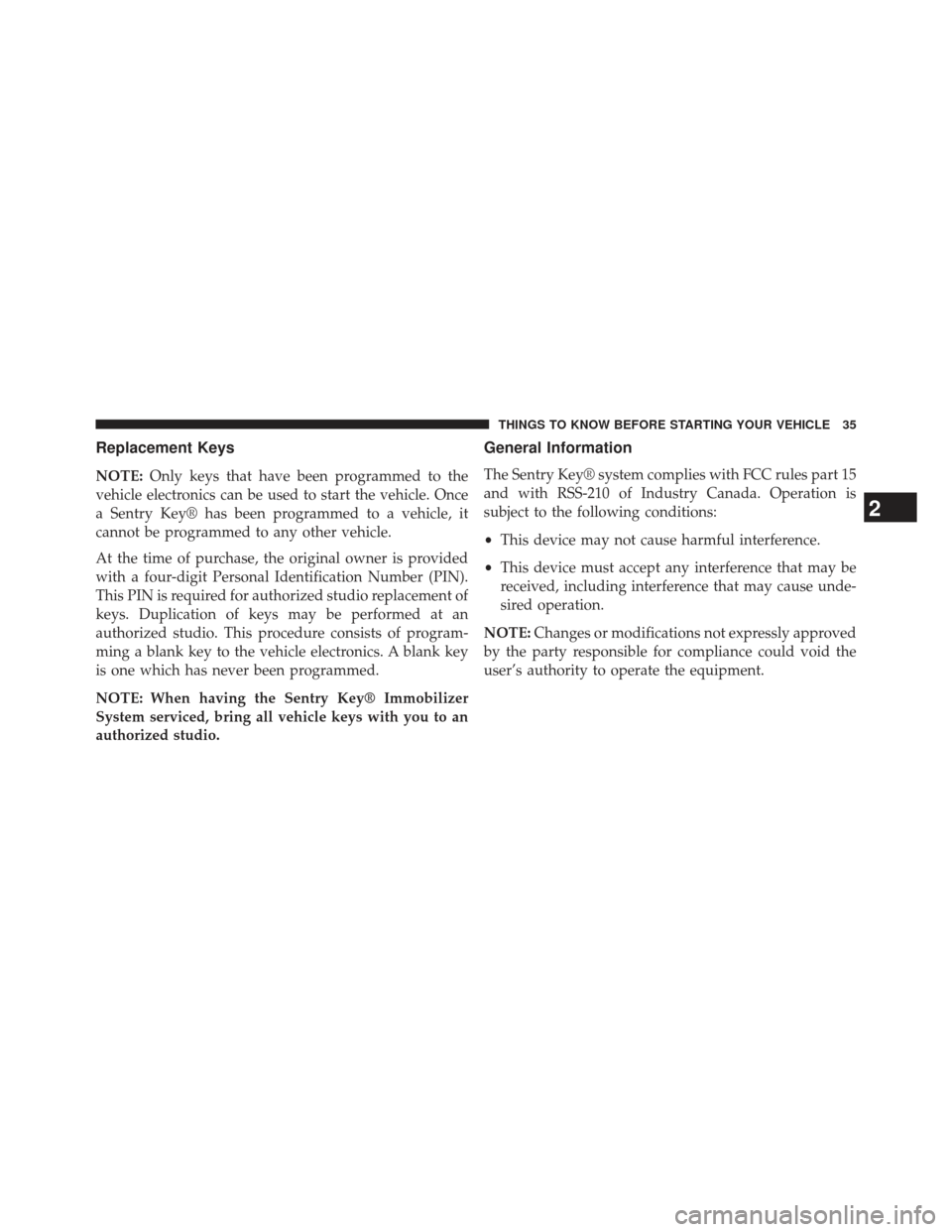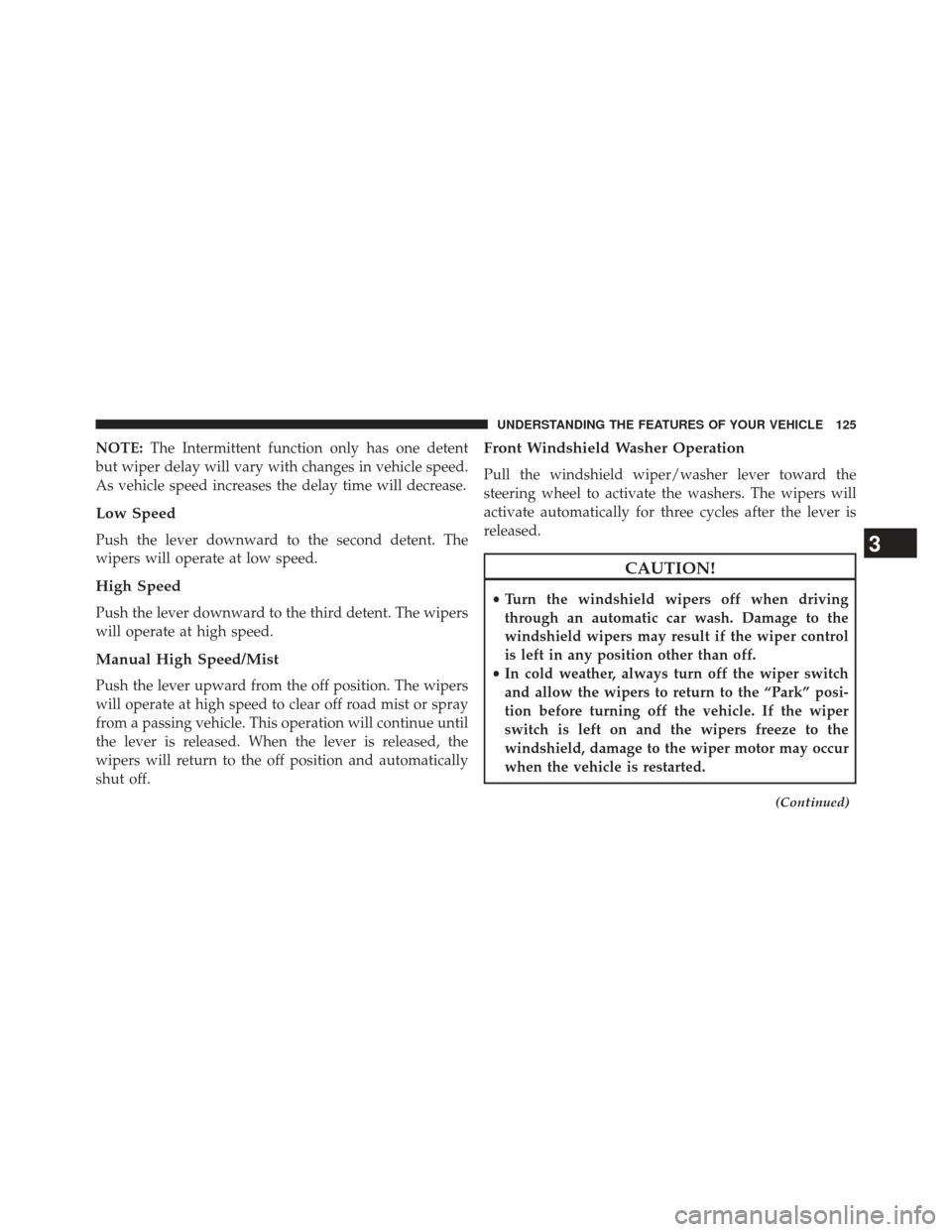Page 26 of 350
The EVSE LED’s will be used to indicate the vehicle’s
connection status if no faults are found during the self
test.
AC LED Fault In-dicatorLED Charge Level Indicator
LED’s
••••••
After the EVSE is connected to the vehicle’s charge inlet
the EVSE will continue to illuminate all LED’s green.
Once the vehicle begins charging the EVSE Charge level
LED’s will illuminate in order from left to right, then shut
off. This pattern will repeat as long as the EVSE remains
connected to AC power.
The LED’s are illuminated and turn off at the rate of one
change per second and the battery is charging.
AC
LED Fault
Indica-
tor LED Charge Level Indicator
LED’s Time
••• ooo1.0
sec
•••• o o 2.0
sec
••••• o 3.0
sec
• • •••• 4.0
sec
Refer to the Level 1 User Manual for any additional
information on its use or operation.
24 THINGS TO KNOW BEFORE STARTING YOUR VEHICLE
Page 37 of 350

Replacement Keys
NOTE:Only keys that have been programmed to the
vehicle electronics can be used to start the vehicle. Once
a Sentry Key® has been programmed to a vehicle, it
cannot be programmed to any other vehicle.
At the time of purchase, the original owner is provided
with a four-digit Personal Identification Number (PIN).
This PIN is required for authorized studio replacement of
keys. Duplication of keys may be performed at an
authorized studio. This procedure consists of program-
ming a blank key to the vehicle electronics. A blank key
is one which has never been programmed.
NOTE: When having the Sentry Key® Immobilizer
System serviced, bring all vehicle keys with you to an
authorized studio.
General Information
The Sentry Key® system complies with FCC rules part 15
and with RSS-210 of Industry Canada. Operation is
subject to the following conditions:
• This device may not cause harmful interference.
• This device must accept any interference that may be
received, including interference that may cause unde-
sired operation.
NOTE: Changes or modifications not expressly approved
by the party responsible for compliance could void the
user’s authority to operate the equipment.
2
THINGS TO KNOW BEFORE STARTING YOUR VEHICLE 35
Page 98 of 350

�LIGHTS .............................119
▫ Multifunction Lever ....................119
▫ Headlights ..........................119
▫ High Beams ........................ .120
▫ Flash-To-Pass ....................... .120
▫ Parking Lights ...................... .120
▫ Daytime Running Lights — If Equipped .....120
▫ Turn Signals ........................ .120
▫ Lane Change Assist ...................121
▫ Follow Me Home/Headlight Delay .........121
▫ Interior Lights ...................... .122
▫ Front Fog Lights — If Equipped ...........123
� WINDSHIELD WIPERS AND WASHERS ......124▫
Front Windshield Wiper Operation .........124
▫ Rear Windshield Wiper .................126
� TILT STEERING COLUMN — IF EQUIPPED . . .127
� ELECTRONIC SPEED CONTROL ...........128
▫ To Activate ......................... .129
▫ To Set A Desired Speed .................129
▫ To Deactivate ....................... .130
▫ To Resume Speed .....................130
▫ To Vary The Speed Setting ...............130
▫ To Accelerate For Passing ................130
� REAR PARK ASSIST — IF EQUIPPED ........131
▫ Rear Park Assist Sensors ................132
▫ Rear Park Assist Alerts ..................132
96 UNDERSTANDING THE FEATURES OF YOUR VEHICLE
Page 123 of 350
NOTE:The indicators will automatically turn off when
the turn has been completed and the steering wheel is
returned to a straight position.
Lane Change Assist
Tap the lever up or down once, without moving beyond
the detent, and the turn signal (right or left) will flash
three times then automatically turn off.
Follow Me Home/Headlight Delay
When this feature is selected the driver can choose to
have the headlights remain on for a preset period of time.
Activation
Remove the key or turn the ignition to the OFF/LOCK
position, and pull the multifunction lever toward the
steering wheel, within two minutes. Each time the lever
is pulled, the activation of the lights will be extended by
30 seconds. The activation of the lights can be extended to
a maximum of 210 seconds.
Turn Signal Operation
3
UNDERSTANDING THE FEATURES OF YOUR VEHICLE 121
Page 127 of 350

NOTE:The Intermittent function only has one detent
but wiper delay will vary with changes in vehicle speed.
As vehicle speed increases the delay time will decrease.
Low Speed
Push the lever downward to the second detent. The
wipers will operate at low speed.
High Speed
Push the lever downward to the third detent. The wipers
will operate at high speed.
Manual High Speed/Mist
Push the lever upward from the off position. The wipers
will operate at high speed to clear off road mist or spray
from a passing vehicle. This operation will continue until
the lever is released. When the lever is released, the
wipers will return to the off position and automatically
shut off.
Front Windshield Washer Operation
Pull the windshield wiper/washer lever toward the
steering wheel to activate the washers. The wipers will
activate automatically for three cycles after the lever is
released.
CAUTION!
• Turn the windshield wipers off when driving
through an automatic car wash. Damage to the
windshield wipers may result if the wiper control
is left in any position other than off.
• In cold weather, always turn off the wiper switch
and allow the wipers to return to the “Park” posi-
tion before turning off the vehicle. If the wiper
switch is left on and the wipers freeze to the
windshield, damage to the wiper motor may occur
when the vehicle is restarted.
(Continued)
3
UNDERSTANDING THE FEATURES OF YOUR VEHICLE 125
Page 168 of 350
•avg. energy
• avg. speed
• elapsed time (driving time).
“Trip B” can be used to display the figures relating to:
• distance
• avg. energy
• avg. speed
• elapsed time (driving time).
Values Displayed
Range
This indicates the distance which may be travelled with
the remaining battery charge, assuming that driving
conditions will not change. The message “----” will
appear when the system is initializing. NOTE:
The range depends on several factors: driving
style, type of route (freeway, residential, mountain roads,
etc.), conditions of use of the car (load, tire pressure, etc.).
Trip planning must take into account the above notes.
Distance Traveled
This value shows the distance covered since the last reset.
Average Speed
This value shows the vehicle’s average speed as a func-
tion of the overall time elapsed since the last reset.
Elapsed Time
This value shows the time elapsed since the last reset.
166 UNDERSTANDING YOUR INSTRUMENT PANEL
Page 178 of 350

Selecting The CD Function
By briefly pressing the MEDIA button, the CD audio
source can be selected (only if a CD is loaded).
Volume Adjustment
To adjust the volume, press the buttons +Vol or –Vol to
increase/decrease the volume.
Mute/Pause Function
Press thebutton briefly to activate the MUTE func-
tion. The volume will gradually decrease and the word-
ing “TUNER Mute” will be shown on the display (in
radio mode) or “CD Pause” (in CD mode).
Press the
button again to deactivate the MUTE func-
tion. The volume will gradually increase until it reaches
the previously set level. When the volume level is changed using the dedicated
controls, the Mute function is deactivated and the vol-
ume is adjusted to the new level selected.
Audio Adjustment
The functions that can be selected from the audio menu
change depending on the context: AM/FM/MEDIA/
SATELLITE.
Press the AUDIO button briefly to change the Audio
functions. After the AUDIO button is first pressed, the
display will show the Bass level value for the source
activated at that time (e.g. in FM mode the display will
show the wording “FM Bass +2”).
Use the buttons
orto scroll through the Menu
functions. To change the setting of the selected function,
use the
orbuttons.
The current status of the selected function appears on the
display.
176 UNDERSTANDING YOUR INSTRUMENT PANEL
Page 185 of 350

Frequency Band Selection
With the Radio mode active, press the FM or AM tuner
button briefly and repeatedly to select the desired recep-
tion band.
Each time the button is pressed the following bands are
selected cyclically:
•AM, FM or SAT (if equipped)
Each band is highlighted by the corresponding wordings
on the display. The radio will be tuned to last station
selected on the respective frequency band.
Preset Buttons
The buttons numbered from 1 to 5 are used to set the
following pre-selections:
• 15 in the FM band (5 in FMA, 5 in FMB, 5 in FMC
• 10 in the AM band (5 in AMA, 5 in AMB) •
15 in SAT (if so equipped) (5 SATA, 5 SATB, 5 SATC)
To listen to a preset station, select the desired frequency
band and then briefly press the corresponding preset
button (from 1 to 5).
By pressing the preset button for more than 2 seconds,
the tuned station will be stored. Pressing the A-B-C
button will change between the preset memory group in
the current frequency band.
Automatic Tuning
Briefly press theorbutton to start the automatic
tuning search for the next station that can be received in
the selected direction.
If the
orbutton is pressed for longer, the rapid
search is started. When the button is released, the tuner
will stop on the next station that can be received.
4
UNDERSTANDING YOUR INSTRUMENT PANEL 183